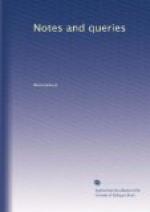M.A. LOWER.
Combs buried with the Dead.—When the corpse of St. Cuthbert was disinterred in the cathedral of Durham, there was found upon his breast a plain simple Saxon comb. A similar relique has been also discovered in other sepulchres of the same sanctuary.
Can any of your learned contributors inform me (for I am totally ignorant) the origin and intent of this strange accompaniment of the burial of the ancient dead. The comb of St. Cuthbert is, I believe, carefully preserved by the Dean and Chapter of Durham.
R.S. HAWKER.
Morwenstow, Cornwall.
Cave’s Historia Literaria.—My present Queries arise out of a Note which I took of a passage in Adam Clarke’s Bibliography, under the article “W. Cave” (vol. ii. p. 161.).
1. Has not the bibliographer assigned a wrong date to the publication of Cave’s Historia Literaria, viz. 1740, instead of 1688-1698?
2. Will some of your readers do me the favour of mentioning the successive editions of the Historia Literaria, together with the year and the place of appearance of each of them?
According to the Biographia Britannica (ed. 2., “Cave, W."), this learned work came out in the year above stated, and there were two impressions printed at Geneva in 1705 and 1720 respectively.
R.K.J.
Julin.—Will DR. BELL, who adverts to the tradition of the doomed city, Julin, in your last number (Vol. ii. p. 178.), oblige me by a “Note” of the story as it is told by Adam of Bremen, whose work I am not within reach of? I have long wanted to trace this legend.
V.
Belgravia, Aug. 17. 1850.
Richardson Family.—Can of your correspondents inform me who “Mr. John Richardson, of the Market Place, Leeds,” was? he was living 1681 to 1700 and after, and he made entries of the births of eleven children on the leaves of an old book, and also an entry of the death of his wife, named Lydea, who died 20th December, 1700. These entries are now in possession of one of his daughters’ descendants, who is desirous to know {231} of what family Mr. Richardson was, who he married, and what was his profession or business.
T.N.I.
Wakefield.
Tobacco—its Arabic Name.—One of your correspondents, A.C.M. (Vol. ii., p. 155.), wishes to know what is the Arabic word for tobacco used in Sale’s Koran, ed. 8vo. p. 169. Perhaps, if he will refer to the chapter and verse, or even specify which is the 8vo. edition which he quotes, some of your correspondents may be able to answer his Query.
M.D.
Pole Money.—Some time ago I made a copy of
“A particular of all the names of the several persons within the Lordship of Marston Montgomery (in Derbyshire), and of their estates, according to the acts of parliament, for payment of pole money assessed by William Hall, constable, and others.”
This was some time between 1660 and 1681. And also of a like




